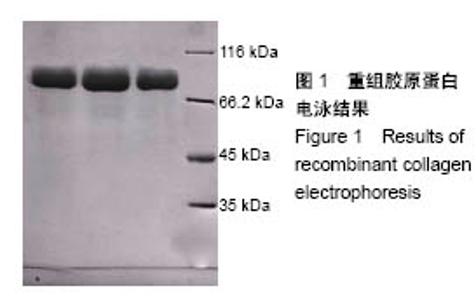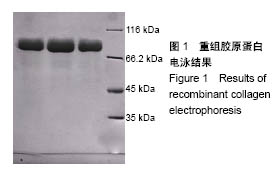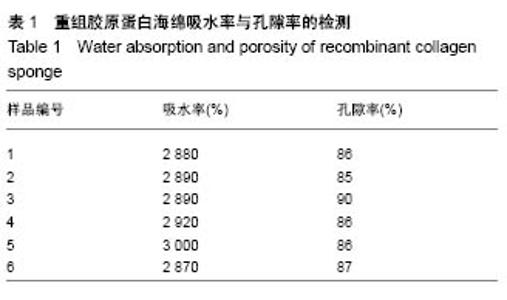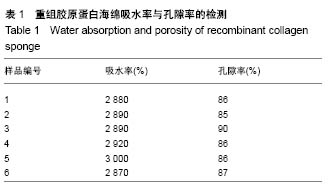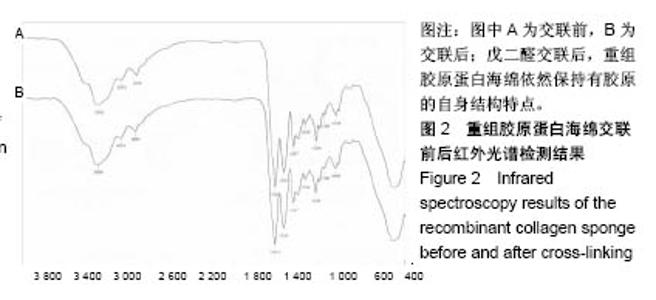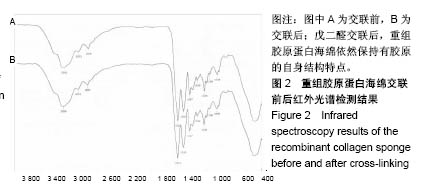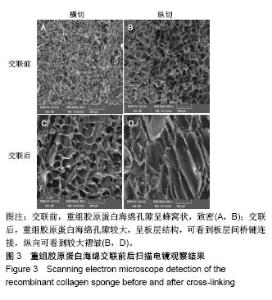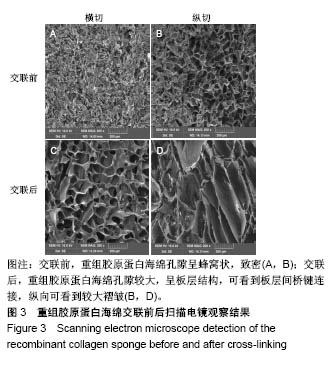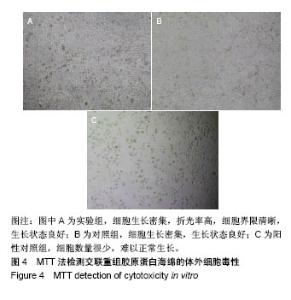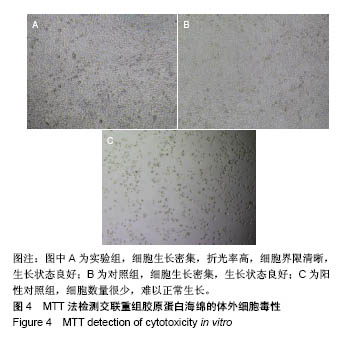| [1] 高长有,马列.医用高分子材料[M].北京:化学工业出版社, 2006:22-26.[2] Deepthi S, Nivedhitha SM, Deepti KJ, et al. Layered chitosan-collagen hydrogel/ aligned PLLA nanofiber construct for flexor tendon regeneration. Carbohydr Polym. 2016;153:492-500. [3] Panwar P, Lamour G, Mackenzie NCW, et al. Changes in structuralmechanical properties and degradability of collagen during aging-associated modifications. J Biol Chem. 2015;290(38): 23291-23306. [4] Walters BD, Stegemann JP. Strategies for directing the structure and function of three-dimensional collagen biomaterials across length scales. Acta Biomaterialia. 2014;10(4):1488-1501. [5] Maynes R. Structure and function of collagen types. Elsevier, 2012. [6] Usha R, Sreeram KJ, Rajaram A, et al. Stabilization of collagen with EDC/NHS in the presence of l-lysine: A comprehensive study. Colloids Surf B Biointerfaces. 2012;90:83-90. [7] 王晓军,惠俊峰,米钰,等.重组类人胶原蛋白的分离纯化[J].中国生物制品学杂志,2003,16(4):212-214.[8] Ramachandran G. Biochemistry of collagen. Springer Science & Business Media, 2013. [9] Jia L, Duan Z, Fan D, et al. Human-like collagen/ nanohydroxyapatite scaffolds for the culture of chondrocytes. Mater Sci Eng C Mater Biol Appl. 2013;33(2):727-734. [10] 柴雅琳,何会霞,肖建喜.重组胶原蛋白-羟基磷灰石复合材料的制备与表征[J].皮革科学与工程,2017,27(4):36-42.[11] Chang L, Liu XL, Di Fan D, et al. The efficiency of magnetic hyperthermia and in vivo histocompatibility for human-like collagen protein-coated magnetic nanoparticles. Int J Nanomedicine. 2016; 11:1175-1185. [12] 陈琳,吕洋,管利东,等.生物支架材料胶原膜交联前后的特性分析[J].中国修复重建外科杂志,2008,22(2):183-187.[13] Murphy CM, Matsiko A, Haugh MG, et al. Mesenchymal stem cell fate is regulated by the composition and mechanical properties of collagen-glycosaminoglycan scaffolds. J MechBehav Biomed Mater. 2012;11:53-62. [14] 何静.胶原蛋白在生物医药工程中的应用研究进展[J].河南科技, 2015, 564(5):104-105.[15] Hu Y, Liu L, Gu ZP, et al. Modification of collagen with a natural derived cross-linker, alginate dialdehyde. Carbohydr Polym. 2014;102(1): 324-332. [16] Tang YP, Yang XL, Hang BJ, et al. Efficient production ofhydroxylated human-like collagen via the co-expression of three key genes in Escherichia coli Origami(DE3). Appl Biochem Biotechnol. 2016;178(7): 1458-1470. [17] Chen MM, Huang YQ, Guo H, et al. Preparation, characterization, and potential biomedical application of composite sponges based on collagen from silver carp skin. J Appl Polym Sci. 2014;131(21):1-8.[18] Inzana JA, Olvera D, Fuller SM, et al. 3D printing of composite calcium phosphate and collagen scaffolds for bone regeneration. Biomaterials. 2014;35(13):4026-4034. [19] 迟妍妍,乐尧金,刘旭昭,等.胶原蛋白海绵的生物特性及体内降解吸收[J].中国组织工程研究,2014,18(34):5515-5519.[20] Antoine EE, Vlachos PP, Rylander MN. Review of collagen I hydrogels for bioengineered tissue microenvironments: characterization of mechanics, structure, and transport. Tissue Eng Part B Rev. 2014; 20(6):683-696. [21] Olsen D, Yang CL, Bodo M, et al. Recombinant collagen and gelatin for drug delivery. Adv Drug Del Rev. 2003, 55(12):1547-1567. [22] 刘振锋,吕卫金,戴圣佳,等.胶原蛋白的提取、改性及应用研究进展[J].食品与药品,2014,16(6):443-447.[23] 刘辉辉,郭善禹.皮肤组织损伤修复的研究进展[J].外科理论与实践,2013, 18(2):188-192.[24] Zhang X, Yang Y, Yao J, et al. Strong collagen hydrogels by oxidized dextran modification. ACS Sustain Chem Eng. 2014;2(5):1318-1324. [25] Gong ZJ, Zhang S, Wang K, et al. Chimeric flaps pedicled with the lateral circumflex femoral artery for individualised reconstruction of through-and-through oral and maxillofacial defects. Br J Oral Maxillofac Surg. 2015;53(2):148-152. [26] Sheu MT, Huang JC, Yeh GC, et al. Characterization of collagen gel solutions and collagen matrices for cell culture. Biomaterials. 2001; 22(13):1713-1719. [27] Chen JT, Zhao YP, Xu Z, et al. Study on the FTIR of Recombinant Collagen and Bovine Type I Collagen. Chin J Mater Res. 2008;22(3): 119-121. [28] 蔡洁.新型交联剂的合成及交联改性胶原的研究[D].广州:华南理工大学, 2014.[29] 程玮璐,李慧,贺金梅,等.可降解复合止血胶原蛋白海绵的制备及生物应用性能研究[J].化学与黏合,2016,38(4):231-234.[30] GB/T16886.1-2011 医疗器械 风险管理过程中的评价与实验.[31] Zhao L, Xian L, Zhao J, et al. A novel smart injectable hydrogel prepared by microbial transglutaminase and human-like collagen: Its characterization and biocompatibility. Mater Sci Eng C. 2016;68: 317-326. [32] 曹谊林,刘伟,张文杰,等.组织工程研究进展[J].上海交通大学学报(医学版),2012,32(9):1241-1250.[33] 邹勇,刘文杰.胶原在止血材料中的应用研究进展[J].明胶科学与技术, 2010,30(1):1-4.[34] Jayalakshmi K, Pasiyappazham R, Vairamani S, et al. Isolation and partial characterization of collagen from outer skin of Sepia pharaonis (Ehrenberg, 1831) from Puducherry coast. Biochem Biophys Rep. 2017;10:39-45. [35] Chan EC, Peshavariya HM, Liu GS, et al. Nox4 modulates collagen production stimulated by transforming growth factor β1 in vivo and in vitro. Biochem Biophys Res Commun. 2013;430(3):918-925. [36] 刘新华,但年华,李正军,等.胶原基复合医用海绵的研究进展[J].西部皮革,2012,35(8):13-18.[37] Si NP, Hye JL, Kwang HL, et al. Biological characterization of EDC-crosslinked collagen-hyaluronic acid matrix in dermal tissue restoration. Biomaterials. 2003;24:1631-1641. [38] Mirazul I, Vytautas C, Chaoliang, et al, Functional fabrication of recombinant human collagen–phosphorylcholine hydrogels. Acta Biomaterialia. 2015;12:70-80. [39] Fagerholm P, Lagali NS, Ong JA, et al. Stable corneal regeneration four years after implantation of a cell-free recombinant human collagen scaffold. Biomaterials. 2014;35(8):2420-2427. [40] 刘文广,May Griffith,Frank Li.基于重组人胶原构建角膜替代物[J].高分子通报,2010,23(8):000001-6.[41] 马慧军,贾赤宇,魏蓉,等.胶原蛋白凝胶促进皮肤创面修复的临床研究[J].中国美容医学,2011,20(2):235-236. |
